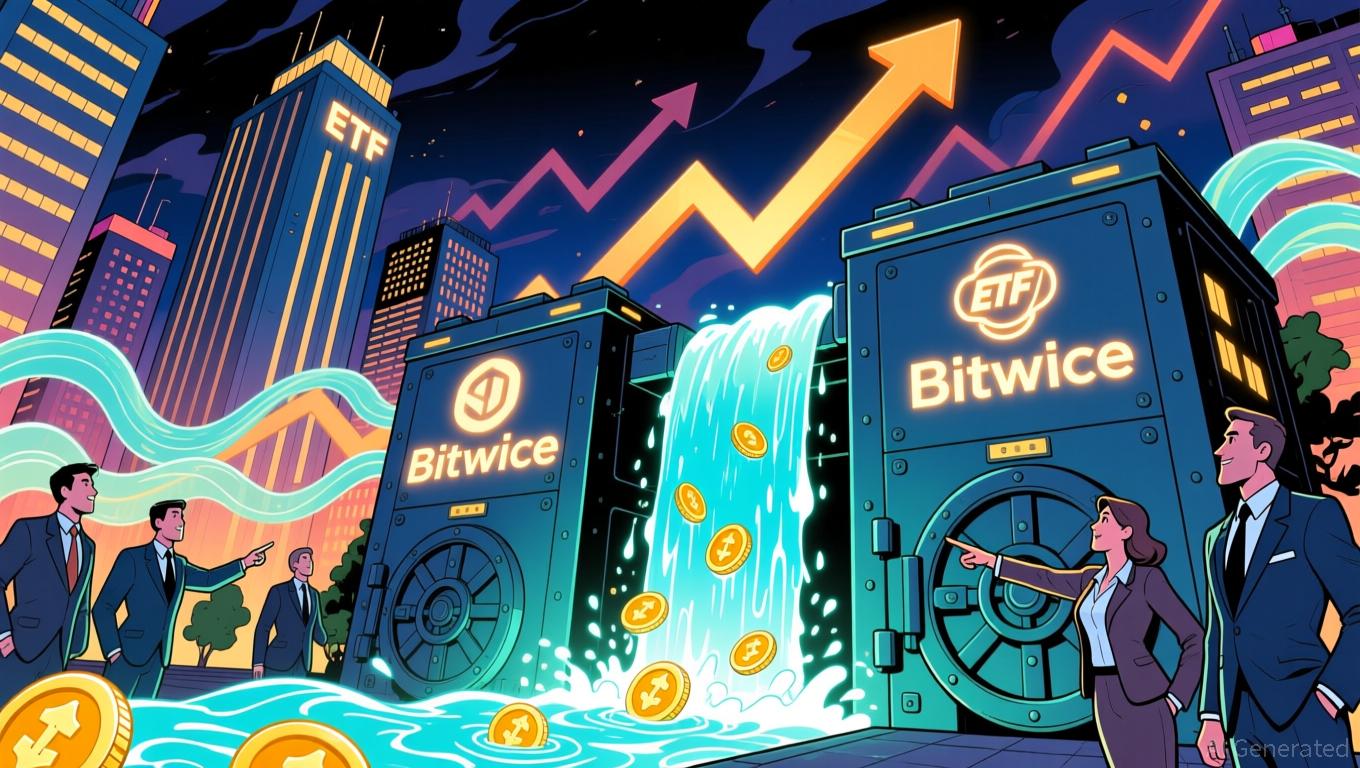Ethereum News Today: Ethereum’s Fusaka Update: Scaling Goals Face Challenges From Validator Compromises
- Ethereum's Fusaka upgrade (Dec 3, 2025) introduces PeerDAS to enhance scalability by verifying rollup data without full dataset downloads. - BPO forks enable incremental blob capacity increases (e.g., 14 blobs/block by Jan 7, 2026), avoiding disruptive hard forks while supporting 100k+ TPS via L2 solutions. - L2 data fees may drop 40%-60% with PeerDAS, but validators face trade-offs between reduced storage demands and increased upload requirements as blob capacity grows. - Market reactions remain mixed:
Ethereum’s Fusaka Upgrade: A Major Leap Forward
Scheduled for activation on December 3, 2025, Ethereum’s Fusaka upgrade is a crucial advancement in the network’s ongoing efforts to boost scalability and data efficiency. The name “Fusaka” merges the previous internal project titles Osaka (execution layer) and Fulu (consensus layer). This upgrade introduces PeerDAS (peer data availability sampling), a new method that lets validators check rollup data without needing to download the entire dataset.
PeerDAS significantly reduces the bandwidth and storage requirements for network nodes, paving the way for Ethereum to handle a higher volume of transactions while upholding its decentralized nature. By dividing rollup data into smaller, erasure-coded segments, PeerDAS maintains data reliability through random sampling. This approach lays the groundwork for gradually increasing the network’s capacity beyond the current six-blob-per-block restriction.

Aligning with Ethereum’s Roadmap
Fusaka is part of Ethereum’s broader development plan, which also includes phases like the Surge (scaling through rollups), Verge (streamlining clients), and Purge (removing outdated history). The upgrade introduces Blob Parameter Only (BPO) forks, allowing for flexible and incremental increases in blob capacity without the need for disruptive, large-scale hard forks. For example, the first BPO fork, planned for January 7, 2026(UTC+8), will raise the blob limit to 14 per block—a 133% increase. This modular approach supports Ethereum’s ambition to process over 100,000 transactions per second (TPS) through layer-2 solutions.
Enhancing Efficiency and User Experience
Fusaka also brings improvements to transaction execution and usability. EIP-7917 introduces deterministic proposer lookahead, enabling rollups to anticipate block proposers and provide quicker pre-confirmations. In addition, EIP-7951 incorporates native support for P-256 cryptographic signatures, aligning Ethereum with widely adopted fintech standards such as FIDO2 and WebAuthn. This could make wallet access easier by supporting biometrics and passkeys, helping to lower barriers for mainstream adoption while maintaining robust security.
Impact on Layer-2 Ecosystems and Validators
The Fusaka upgrade is expected to have a notable effect on layer-2 (L2) networks. Industry experts predict that the combination of PeerDAS and BPO forks could cut L2 data fees by 40% to 60% over time, especially benefiting high-volume applications like decentralized finance (DeFi) and gaming. For validators, the upgrade means less storage is needed for new nodes due to extended history expiry, but higher upload requirements as blob capacity grows, which may favor larger operators. ETH holders stand to gain from a more efficient settlement layer, though concerns remain about protocol complexity and user costs if fees do not decrease.
Building on Recent and Future Upgrades
Fusaka follows a series of Ethereum enhancements, including the Pectra upgrade in May 2025, which brought account abstraction and changes to staking. This steady pace of development highlights Ethereum’s transition from foundational changes, like the Merge in 2022, to more targeted, value-driven improvements. Looking ahead, the “Glamsterdam” upgrade in 2026 is set to further refine proposer-builder separation and optimize block execution.
Market Response and Outlook
Reactions to Fusaka have been varied. In early December 2025, Ethereum’s price climbed 5% to $2,922(UTC+8), even as ETH investment products saw net outflows of $589 million amid broader market turbulence. A notable $44.5 million long position by a major trader on Hyperliquid signals optimism, though experts remain split on whether Fusaka will spark a lasting rally.
The Road Ahead for Ethereum
As Ethereum evolves into a modular, high-throughput platform, Fusaka stands as a pivotal milestone. By carefully balancing scalability, decentralization, and user experience, this upgrade strengthens Ethereum’s position against new blockchain competitors while maintaining its pioneering edge. The network’s future success will hinge on the smooth rollout of upcoming upgrades and the community’s ability to adapt to changing needs.
Disclaimer: The content of this article solely reflects the author's opinion and does not represent the platform in any capacity. This article is not intended to serve as a reference for making investment decisions.
You may also like
Ethereum News Update: ZKP’s Hardware-Centric Strategy Shakes Up Speculation-Fueled Crypto Presales
- ZKP launches with $17M pre-built Proof Pods, offering instant AI compute rewards via Wi-Fi-connected hardware. - Unlike speculative presales, ZKP's hardware-first model ensures operational readiness and decentralized network resilience. - Competitors like Blazpay and SpacePay focus on utility-driven crypto adoption, but ZKP's tiered, upgradable devices emphasize verifiable performance. - Ethereum's gas limit increase aligns with ZKP's distributed compute approach, addressing scalability challenges throug

Solana News Update: Investors Shift Toward XRP ETFs, Bringing Solana's 21-Day Inflow Streak to a Close
- Solana ETFs ended a 21-day inflow streak with a $8.1M net outflow on Nov 27, 2025, led by 21Shares TSOL's $34.37M redemptions. - This reversal contrasted with Bitcoin/Ethereum ETFs' $5.43B outflows and highlighted Solana's 7% staking yields and 70M daily transactions. - Analysts linked the shift to profit-taking, macroeconomic pressures, and investor rotation toward XRP ETFs with perfect inflow records. - Despite the outflow, Solana ETFs still hold $964M in assets, but face challenges as TVL dropped 32%

XRP News Today: Institutional ETFs Drive XRP to Compete with Bitcoin's Market Leadership
- XRP ETFs see $160M+ inflows as institutional demand surges, with Bitwise and Franklin Templeton leading the charge. - NYSE approves Grayscale and Franklin XRP/Dogecoin ETFs amid SEC easing altcoin fund approvals, signaling crypto normalization. - Altcoin Season Index at 25/100 shows Bitcoin dominance, but projects like Aster and Zcash outperform BTC by 1,000%+. - XRP rebounds to $2.06 with 48% volume spike, but 79M tokens absorbed by ETFs raise supply concerns. - Institutional-grade custody solutions fro

Public-Private Collaborations Driving Real Estate and Industrial Expansion in Webster, NY
- Webster , NY, leverages PPPs via FAST NY and NY Forward grants to boost infrastructure, real estate , and industrial investment. - Xerox campus upgrades and downtown revitalization projects enhance connectivity, attracting advanced manufacturing and logistics sectors. - $650M fairlife® facility creates 250 jobs, demonstrating how modernized infrastructure attracts high-value industries to secondary markets. - Websters model shows PPPs can drive sustainable growth by aligning public funding with private-s
